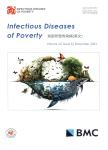Patterns of tsetse abundance and trypanosome infection rates among habitats of surveyed villages in Maasai steppe of northern Tanzania
作者机构:School of Life Sciences and BioengineeringNelson Mandela African Institution of Science and TechnologyP.O.Box 447ArushaTanzania Genome Sciences CenterDepartment of MicrobiologyParasitology and Immunology.College of Veterinary and Medical SciencesSokoine University of AgricultureMorogoroTanzania Centre for Infectious Disease DynamicsThe Huck Institutes of the Life SciencesThe Pennsylvania State UniversityUniversity ParkUSA Department of Conservation BiologySchool of Biological SciencesUniversity of DodomaDodomaTanzania Department of Geography and Environmental studiesUniversity of DodomaDodomaTanzania
出 版 物:《Infectious Diseases of Poverty》 (贫困所致传染病(英文))
年 卷 期:2017年第6卷第1期
页 面:1111-1122页
核心收录:
学科分类:1004[医学-公共卫生与预防医学(可授医学、理学学位)] 1002[医学-临床医学] 1001[医学-基础医学(可授医学、理学学位)] 07[理学] 0701[理学-数学] 070101[理学-基础数学]
基 金:This research received financial support from the project“Predicting vulnerability and improving resilience of the Maasai communities to vector borne infections:An Eco-health approach in Maasai steppe ecosystem based at Nelson Mandela African Institute of Science and Technology(NM-AIST)”
主 题:Habitat variability Tsetse fly Host availability Infection rate Trypanosomes
摘 要:Background:Changes of land cover modify the characteristics of habitat,host-vector interaction and consequently infection rates of disease causing *** this paper,we report variations in tsetse distribution patterns,abundance and infection rates in relation to habitat types and age in the Maasai Steppe of northern *** Africa,Tsetse-transmitted trypanosomiasis negatively impacted human life where about 40 million people are at risk of contracting the disease with dramatic socio-economical consequences,for instance,loss of livestock,animal productivity,and ***:We trapped tsetse flies in dry and wet seasons between October 2014 and May 2015 in selected habitats across four villages:Emboreet,Loiborsireet,Kimotorok and Oltukai adjacent to protected *** collected include number and species of tsetse flies caught in baited traps,PCR identification of trypanosome species and extraction of monitored Normalized Difference Vegetation Index(NDVI)data from Moderate Resolution Imaging Spectrometer(MODIS).Results:Our findings demonstrate the variation of tsetse fly species abundance and infection rates among habitats in surveyed villages in relation to NDVI and host *** have shown higher tsetse fly abundance in Acacia-swampy ecotone and riverine habitats for Emboreet and other villages,*** abundance was inconsistent among habitats in different *** was highly infested with Glossina swynnertoni(68%)in ecotone and swampy habitats followed by ***(28%)and ***(4%)in riverine *** the remaining villages,the dominant tsetse fly species by 95%was *** in all *** vivax was the most prevalent species in all infected flies(95%)with few observations of co-infections(with *** or ***).Conclusions:The findings of this study provide a framework to mapping hotspots of tsetse infestation and trypanosomiasis infection and enhance the communities to plan for effect



